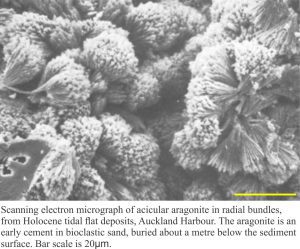This is part of the of How To…series… on carbonate rocks
The diagrams and images of carbonate crystal habits and cements are descriptive and intended to provide essential background to other posts that detail the different diagenetic environments.
Carbonate diagenesis is like a game of two halves: one part involves mineral dissolution, the other precipitation. The two commonly go hand-in-hand; it all depends on the changing fortunes of thermodynamic stability and interstitial fluid flow as the game progresses.
Cements precipitate in available pore space: intergranular, intragranular (like the whorls of gastropods, the septa of corals, or the chambers of foraminifera), larger voids like those developed in reef frameworks, and microporosity such as pore throats between grains. Neomorphism and mineral replacement involve dissolution and precipitation that change existing cement fabrics and sediment frameworks and hence are not confined to pore space.
Carbonate cements are as varied as the diagenetic environments in which they form – the sea floor, meteoric, deep burial and everywhere in between. The crystal shapes of CaCO3, it’s polymorphs and chemical variants range from needle and whisker-like, to blocky spar. The transitions from one crystal form to another, their growth in open pores, and replacement by stable carbonate phases is what makes carbonate petrography so fascinating. Continue reading

